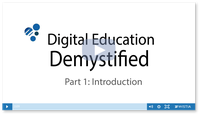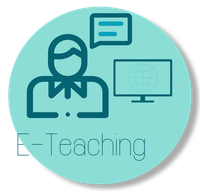Important Terms
|
|
What does e-learning actually mean? What is the meaning of the terms "blended learning", "e-teaching" or "e-assessment" and what do this terms have to do with the digitalization of teaching in higher education? Lehre 4.0 sheds light into the dark!
This page is constantly growing with the project and is regularly filled with new content. Unless otherwise stated, the following sources are valid: e-teaching.org • ilias.uni-giessen.de/ilias |
|---|---|
 |
In our extensive glossary you will find a wide range of terms related to e-learning and digitally supported higher education teaching. |
 |
In the context of higher education, we very often hear the term "e-learning" as a generalization; there is so much more to it than is initially assumed. As the name suggests, e-learning refers to all forms of learning in which electronic or digital media are used. In particular, the term "e-learning" refers to an arrangement of digital media and virtual learning spaces. It can be used individually or also jointly in a group for competence development and education. The learning contents are presented here in a multimedia format and enable users to work on them autonomously and independently of location within a self-determined time frame. (Source: Arnold, Patricia; Kilian, Lars; Thillosen, Anne; Zimmer, Gerald (2018): Handbuch E-Learning. 5. Aufl. Bielefeld: S.23: translated by Lehre 4.0 team)
Watch part one of our video series "Digital Education Demystified" |
 |
What does the term E-Teaching mean?
The term "e-teaching" (electronic teaching) aims in particular at the perspective of teachers and teaching, whereas the term e-learning refers to the arrangement of digital learning media and virtual spaces. (Source: Arnold, Patricia; Kilian, Lars; Thillosen, Anne; Zimmer, Gerald (2018): Handbuch E-Learning. 5. Aufl. Bielefeld: S.23: translated by team Lehre 4.0) |
 |
What does the term E-Assessment mean?
"E-Assessment" offers a variety of new forms of assessment that relieve the examination process, through electronic support easier for teachers. In addition to monitoring learning success, it also provides students with information on the status of their own learning process. The term "e-assessment" continues to be frequently associated with automatically evaluateable mass examinations, which enable students to obtain rapid feedback on their examination results. (Source: Arnold, Patricia; Kilian, Lars; Thillosen, Anne; Zimmer, Gerald (2018): Handbuch E-Learning. 5. Aufl. Bielefeld: S.38ff : translated by Lehre 4.0 team) |
 |
What does Blended Learning actually mean? Blended Learning describes a teaching scenario between media-supported presence teaching and pure online teaching. In other words, it is traditional classroom teaching with digital components. (Source: https://www.e-teaching.org/lehrszenarien/blended_learning (Accessed: 10.07.2019 : translated by Lehre 4.0 team)) |
 |
Synchronous teaching and learning Synchronous teaching and learning is characterised by the fact that learners and lecturers are in different places at the same time and communication takes place (almost) without time delay. This allows the learners to ask questions or contribute to discussions. Examples of synchronous teaching and learning in digital space:
(Source: https://www.e-teaching.org/materialien/glossar/synchrones-lernen (Aufruf: 27.09.2020)) |
 |
Asynchronous teaching and learning The term asynchronous teaching and learning refers to teaching/learning processes in which communication and interaction between lecturers and learners take place at different times. Examples of asynchronous teaching and learning in digital space: (Source: https://www.e-teaching.org/materialien/glossar/asynchrones-lernen (Aufruf: 27.09.2020))
|
|
The non-commercial portal e-teaching.org is a service of the Leibniz Institute for Knowledge Media and offers an extensive directory of all important terms on the subject of "e-learning" and "e-teaching". It's well worth stopping by. |
|

